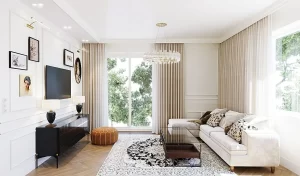Biophilic Interior Design

The idea of Biophilic Interior Design is to use materials that are in harmony with the natural world. The colors used in biophilic interiors are subtle, natural, and soothing. For example, soothing blues and greens can be the backdrop for a space, with floral designs and other natural objects serving as accents.
For a biophilic interior space, choose elements that mimic nature’s details and shapes. This could include using natural wall murals, botanical sculptures, floral installations, or moss mosaics. Planting plans can also contribute to the biophilic effect of the space. While natural elements like flowers and ferns are best when they are placed in gardens, there are other ways to evoke a nature-like atmosphere inside your home.
Biophilic interior design can be achieved through the use of indoor plants and stained wooden decor. It doesn’t require structural integration, but it can improve your overall visual aesthetic. You can also install large windows and doors to the outdoors, allowing fresh air to flow through the space. This can improve your mood and overall well-being.
Another benefit of Biophilic Interior Design is improved comfort. Hospitals have seen a decrease in high blood pressure patients as a result of biophilic designs. Furthermore, the use of natural materials improves sustainability in the workspace and home office. When people’s needs are met, homes become more fulfilling and peaceful.
Biophilic design is a way to create environments that enhance our sense of well-being and promote community. It is a design concept that has been gaining popularity because it considers our physical, mental, and social needs. It can be applied to nearly every aspect of interior design. For example, wooden furniture can mimic the sound of nature, while playing recordings of bird songs or the sound of running water can add to the biophilic effect.
In addition to workplaces, healthcare facilities, and assisted-living facilities, biophilic design can also be applied to residential homes. It has even been used in long-term residential care for dementia patients. Additionally, biophilic design can improve mental health and prevent cognitive decline in older adults. It can also be used for rehabilitation.
Biophilic design has become one of the hottest trends in interiors and architecture today. As the name implies, biophilic design is scientifically-based and is the perfect blend of art and science. It uses evidence-based design techniques that integrate natural elements into our interiors to promote our well-being.







